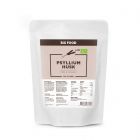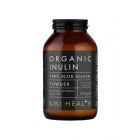Top 5 Benefits of Increasing Fibre in your Diet
- By Patrick McCarthy (MSc)
- 24 Apr 2021


We often hear fiber nowadays. But despite public recommendations pushing the whole grain and fiber agenda, people still don’t seem to have the full picture of its benefits! It is my firm belief that when delivered the “Why”, people are more likely to adhere to the recommendations.
In this article, I’ll highlight five good reasons why fiber is the wonder nutrient as well as some practical tips for increasing the amount you consume.
1. Colon Health
One of the primary reasons that fiber is so crucial in our diet, is because it is an indigestible starch. This means it will be passed through the digestive tract and excreted. This can help to keep us regular and our bowel movements frequent, promoting the removal of other waste along with it.
Some fibers are known to be insoluble (don’t absorb well in water), while others are soluble (draw water).
Soluble (viscous is used now) fiber was the term to describe that which draws water and absorbs quite easily. This type of fiber can help improve constipation as it adds water to the stool and softens it for easy transit.
2. Promotes Fullness and Weight Loss
Increasing fiber in the diet has been shown to enhance weight loss efforts by increasing feelings of fullness for longer (Source: Harvard Health).
Fiber is not broken down in the GI tract and so takes up more space, which means it can stimulate feelings of fullness when consumed.
Increasing satiety, another word for fullness, will help to unconsciously eat less, and make it easier to achieve and maintain a consistent caloric deficit.

3. Blood Sugar Regulation
There's a difference between 10g of sugar from an apple and from a chocolate bar. Physiologically as an end product, there's not much of a difference. They will both be either burned as fuel, stored as glycogen, or, if those stores are already full, fat.
What’s the difference between sugar from fruits from added sugar?
The difference lies in how the body breaks down these foods and nutrients. The sugar from the apple is not directly available and needs to be liberated from fiber and other phytonutrients. This takes time, which results in a slow-drip release of the sugar into the bloodstream.
On the other hand, the 10g of “free” sugar in the chocolate bar is readily available and will be absorbed rather quickly. This will cause a small spike in blood sugar, followed by an insulin response, which will lead to feelings of hunger shortly after eating. Some studies have shown improved blood glucose profiles among those with diabetes when eating a high-fiber diet (Source: AAC).
4. Cholesterol Regulation
This one is a little less defined than the others, but still very promising. There is some research to indicate that increased soluble fiber in the diet can help to reduce LDL (the dangerous type of cholesterol) levels!
How does fiber impacts cholesterol levels in our body?
- Soluble fiber draws water into the colon, which limits the absorption of some fat and cholesterol
- Soluble fiber binds bile acids and cholesterol in the intestine. It is believed that because cholesterol is a key ingredient in bile acid formation, increased bile excretion can improve cholesterol clearance from circulation. However, the science isn’t there yet to make this conclusion (Source: AGRIS).
- More evidence suggests that increased cholesterol clearance leads to an increased LDL uptake by the liver (Source: Oxford).

5. Thriving Gut Microbiome
If you read our last article about digestive enzymes and gut microbiome, you’ll know how important it is to supply a diverse range of beneficial bacteria with food.
Their food comes in the form of fermentable fibers that we consume from a variety of different fruits and vegetables. The beneficial bacteria feed on these different types of fibers and produce short-chain fatty acids. These are important to support immune function and cell health.
In addition to this, the healthier and more abundant our community of beneficial bacteria, the thicker and more resilient the protective layer is in our gut.
What is the daily recommended intake of fiber?
From all the above information, it should now be clear that fiber is crucial in the diet. In one of the largest studies of over 4,600 participants, it was found that higher intakes of fiber were associated with several improved outcomes.
Specifically, those that had at least 25 grams of fiber a day had improved weight, blood pressure, blood sugar, cholesterol, and risk of mortality from several conditions (Sources: Lancet).
Based on this and more, the American Heart Association (AHA) recommends consuming at least 20 grams of fiber a day in the form of food, and not supplements (Source: AHA). Stay tuned for more fiber-related posts, including some practical ways of increasing your daily intake.









